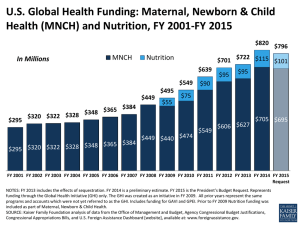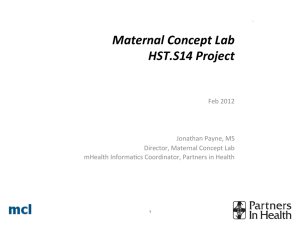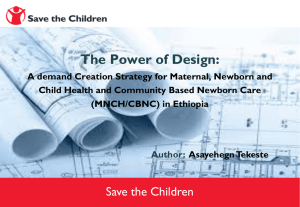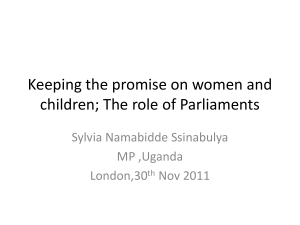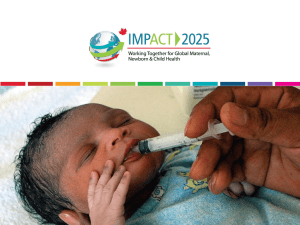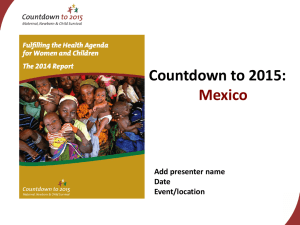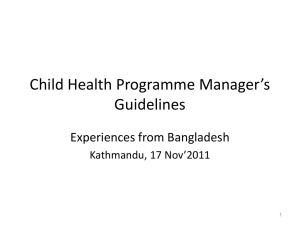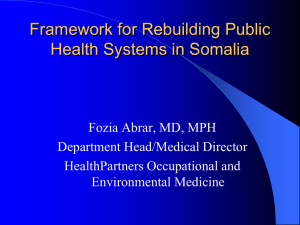Dr. Caroline Phiri - Zambia UK Health Workforce Alliance
advertisement
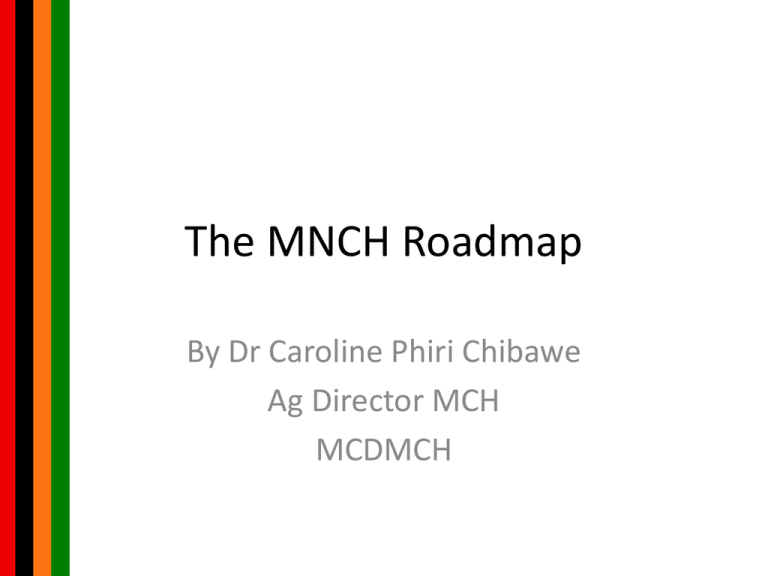
The MNCH Roadmap By Dr Caroline Phiri Chibawe Ag Director MCH MCDMCH What is this MNCH Roadmap? • A strategic document identified that highlights the need to address the problems of high maternal, neonatal, infant and under-5 mortality rates in Zambia over the next 10 years. Goal • Accelerated reduction of maternal, newborn and childhood morbidity and mortality to attain set targets by 2015. • (Thereafter focus on attaining universal coverage goals from 2016 to 2019 and aim to attain universal coverage (80% and above – nationally and within each district) Objectives in MNCH Strategic plan • To reduce maternal mortality from 591 to 162 per 100,000 live births • To reduce neonatal mortality from 34 to 20 per 1,000 live births • To reduce Under-5 mortality rate from 119 to 64 per 1000 live births (based on ZDHS 2007) Specific Objective • Provide skilled attendance during pregnancy, childbirth, and the postnatal period, at all levels of the health care delivery system • Strengthen the capacities of individuals, families, communities, line Ministries, and the private sector to share responsibility and play their role in efforts to significantly improve MNCH outcomes for universal coverage to attain the set MDGs. Situational Analysis Maternal and newborn health situation in Zambia • Maternal mortality ratio – 591/100,000 live births • Neonatal mortality rate – 34/1000 live births • Infant mortality Rate – 70/1000 live births • Under five mortality rate – 119/1000 live births • Fertility rate 6.8 • HIV prevalence – 14 % Men – 12 % Women – 16 % Comparison of MMR versus SBA Progress & trends towards reducing the Maternal Mortality Ratio [MMR] to attain the MDG target of 162 by 2015 in Zambia al mortality ratio (Zambia) Proportion of women (%) attended to by skilled health workers during birth in Zambia 52% Maternal dealths/ 100,000 live births 800 729 700 50% 649 600 48% 591 500 46% 400 44% 300 42% 200 40% 200 162 100 38% 1992 1996 1999 2001 2007 0 1992 1996 2001 2007 Source: Zambia DHS data sets 2015 Source: Zambia DHS data sets Issues around the high MMR and NMR in Zambia • TBA to train or not to train • Three delay model • Inadequate equipment Indirect effect of HIV, malaria and TB. • reduced funding affected out reach services • Reduced Human resources Rural versus Urban disparities • Long distances to health facilities & high cost of care • Uneducated, poor and living in rural areas. • Less likely to attend 4 FANC visits, rarely seek ANC services in 1st trimester • ANC services tend to be poor quality with • inadequate drugs, laboratory services • more likely to be seen by an unskilled health worker and rarely by a physician. Rural versus Urban disparities • Poor, rural, uneducated and multigravida women tend to deliver at home by unskilled TBA or relatives. • No access to FP, postnatal and new born care • No outreach services for Immunisation and GMP • Schools have few teachers, high illiteracy rate, poverty, (access to social welfare ??) • Early age marriages leading • Obstetric complications, malnutrition, Key Strategies to be implemented 1. The continuum of care approach recognizes five critical phases in the life cycle of women and children which are: – Adolescence and pre-pregnancy – pregnancy, – childbirth and the postnatal period, – newborn and – childhood Key Strategies to be implemented 2. Using a three dimensional approach in coming up with strategies and interventions; – ensuring engagement and synergy between the health system, communities, other line ministries and the private sector 3. Strengthening partnerships with the donor community and the private sector for sustainable long-term predictable financing to achieve universal coverage. Advocacy and Resource Mobilization • Advocacy efforts will : – Increasing the budget allocation for MNCH interventions from both internal and external resources – Revision of laws, policies that hinder effective provision of maternal, newborn and childcare services – Improving the production, employment, deployment and retention of a skilled health work force at all levels – Institutionalize the Maternal Death Reviews and make maternal deaths to be made notifiable events Adolescence and pre-pregnancy • investment in – Information – to prevent sexually transmitted diseases, HIV, and unwanted pregnancies – Education – Availability and easier access to contraceptive services and supplies. • The underlying thinking is that a good outcome of pregnancy starts before conception. Pregnancy • The thrust in interventions is ensuring provision of skilled care during pregnancy. • provide quality FANC – promote birth plan – helping the family prepare for good parenting. Childbirth and the postnatal period • Focus on skilled, professional care during childbirth • – providing access to professional skilled care before, during and after childbirth; – Train Health workers to provide quality Emergency obstetric and newborn care – Skilled and professional care should also be available to the mother during the postnatal period Newborn (neonatal): • bridging the postnatal and postpartum gap, ensuring no interruption in the continuum of care, and – establish mechanisms for communication and handover between maternal and child programmes – mix of approaches, from the improved care of newborns within the home, through home visits by health workers, better uptake of services in case of problems and referral when needed. Childhood • • • • • • The Expanded programme on Immunisation “Integrated Management of Childhood Illness” (IMCI) Management of the newborn, nutrition promotion, the strengthening of school health programmes, shifting focus from health centres alone to a continuum of care that implicates families and communities, health centres, and referral-level hospitals Health System Strengthening and Capacity Development • Health system strengthening for MNCH will comprise of improving service delivery by strengthening: – – – – The health workforce, Adopting Results Based Management (RBM) approaches, The health management information system (HMIS), The logistics management of medical products, vaccines and technologies, – Increased financing to comply with Abuja target of 15%, – Improving the infrastructure for service delivery, and – Strengthened planning, leadership and governance Referral System • Improve referral system through: • appropriate transportation and improving linkages between community and referral facilities • Communications equipment (e.g., radio calls and mobile phones). • Community structures for handling MNCH emergencies • Mothers’ waiting shelters Community Mobilization – Educating and sensitising communities on community-based MNCH interventions – Mobilizing resources at the village level for MNCH including emergency referral as well as building and strengthening health facilities. – Orienting the facility governing committees to the MNCH Strategic Plan to ensure effective – implementation of the plan at the health facility and community levels – Institutionalizing ‘village health days’ Behaviour Change Communication (BCC) • Use of BCC approaches for quality MNCH including nutrition and adolescent sexual reproductive health. • Target community-based initiatives • Use of targeted mass campaigns Fostering Partnerships and Accountability • Effective implementation of this MNCH Strategic Plan will require • stimulating and establishing strategic partnerships • improve coordination and collaboration between communities, partners • galvanizing political will and mobilizing resources for long-term sustainable MNCH interventions. • Coordinate regular planning, implementation, monitoring and evaluation of MNCH interventions to assess progress towards attainment of the MDGs. Monitoring and Evaluation Framweork • One agreed indicator of maternal, newborn and child health interventions will be evaluated • 33 operational targets developed • Include nutrition, water and sanitation and systems strengthening • Quantitative indicators • Qualitative indicators obtained through periodic and commissioned studies. • Sources of data will include both the routine and non-routine health information systems • The indicators will be updated from time to time as need arises Operational targets Indicator Current status Target Unmet need for Contraceptives 27% 14% Modern Contraceptive rate for women of Reproductive age 33% 58% Teenage Pregnancy 28% 18% % of women accessing ANC in first Trimester 19% 58% % of women accessing 4 or more ANC visits 60% 80% % of women on IPT 2 or more 66% 80% Proportion of women delivered by skilled HW 47% 75% Proportion of women accessing postnatal care within 2 days weeks 39% 55% % of women accessing PMTCT Operational targets Indicator Current status Target % of women initiating early and exclusive breastfeeding 63% 90% % of districts with 50% HF implementing kangaroo care % 80% % of children receiving correct treatment for fever 38% 80% % Vitamin A supplementation 60% 80% % of households women accessing improved drinking water 24% 80% % of households accessing improved sanitation 42% 80% % of districts conducting maternal death reviews 50% 100% Implementation Arrangements • Involvement of a multisector approach to increase access to health services • MCDMCH and Ministry of Health • Other Ministries such as Finance, Information, chiefs and traditional affairs, Local Government, Agriculture, Work and supply, Education, gender, DMMU • Cooperating partners- NGO and private sectors Conclusion • The strategies are packages of interventions for each phase of life cycle and at each level of intervention within each selected intervention. • The interventions have been costed • Implementation of the MNCH plan should not be done in silos but comprehensively. For a healthy nation, invest in us now! A prosperous, middle income Zambia requires healthy mothers and healthy newborns.
